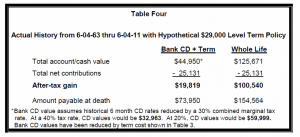In a world where almost every talking head and financial pundit (think Suze Orman and Dave Ramsey) is telling you that cash value life insurance and particularly whole life insurance are terrible, we stand atop the shining city on the hill and declare them wrong. As a matter of fact, it’s great up here, and we recommend you check out the view!
Alas, so far, most of our cries have gone unheard.
The Truth about Cash Value Life Insurance
Those who chose to listen and keep an open mind to the possibilities are pleasantly amazed to see how cash value life insurance serves as an alternative investment. They quickly realize that the problem isn’t with the product itself but often how it is structured and presented by unscrupulous salespeople.
With all that said, the task to combat the negative press surrounding life insurance and in particular the use of it as an asset class is arduous at times. Brandon and I spend an inordinate amount of our time discussing this topic amongst ourselves and are always searching for ways that we can better make the case for what we know is true.
In light of this, I remembered an article that I stumbled upon a few years ago that was published via Assurity Life. The piece, written by Richard L. Miller, CLU, ChFC, is titled, “The Truth About Participating Whole Life: Is whole life an obsolete product? A 49 year actual case history provides the surprising answer.”
Link to The Truth About Participating Whole Life
Well, for a nerd like me, that’s a really catchy title…he had me at “the truth about participating whole life.” What can I say? I’m a sucker for defense of the intellectual high ground I’ve chosen to stake my family’s future on.
Needless to say, Mr. Miller has concluded one of the most exhaustive studies I’ve ever seen regarding whole life insurance and how it compares to various alternatives: buy term and invest the difference, purchasing GUL and investing in CDs vs. whole life, and purchasing variable life vs. whole life insurance.
What makes this study so interesting to me is that he is using 49 years of real data from a policy that was issued back in 1963. The updates occur every June and include actual numbers from a policy that has been in force for the past half-century. And, he’s updated it every year since he originally published the article back in 2009.
Most of the time when we are making intellectual arguments in the investment and insurance world, we are doing so with projections and often do not have the luxury of comparing actual performance. Mr. Miller’s paper has real numbers spanning decades, and that alone warrants taking the time to read it.
Take a look at how the numbers stack up; I think you’ll be impressed.
Also, it’s worth mentioning that Assurity is no slouch, but it certainly hasn’t cornered the market on participating whole insurance performance.
The Highlights of Using Cash Value Life Insurance
Once again, I really do encourage you to take the time to read the article. Mr. Miller has done a great job of putting “insurance speak” into plain English so that anyone who reads it will be able to follow along.
Our condensed version highlights some of the main points he makes that are worth repeating:
- When comparing whole life to other alternative investments, make sure you compare the performance to other types of investments with a similar risk/reward profile.
Many times, those who have some particular disdain for cash value life insurance want to compare what you earned in your whole life policy with what you could have earned if you’d bought, say, an S&P 500 index fund, which is not a fair comparison at all.
Whole life insurance is extremely stable, has contractual guarantees, and will never suffer a loss in the value unless you take a withdrawal. Mr. Miller uses CDs and U.S. savings bonds as comparative investments because they have a similar risk profile.
(click the image to enlarge)
- Always consider the impact of income taxes.
They have a tremendous compounding effect on a buy term and invest the difference strategy over a 40 or 50 year period. Don’t discount the eroding effect of taxes.
- Consider the facts.
If the subject of this study, Mr. Frank Smith, had purchased term insurance back in 1963, he would either no longer have insurance coverage due to the expiration of his term period or he would have paid much more in insurance costs to maintain his coverage than he would have paid for 49 years of whole life insurance.
My conclusion
Please take time to look at the actual numbers presented in this study. And, always take the time to look at the numbers in your particular situation. Don’t just take someone at their word; take the time to make an objective decision based on facts.
We help people look at the facts and analyze their cash value life insurance every day; just let us know if we can help you too.


